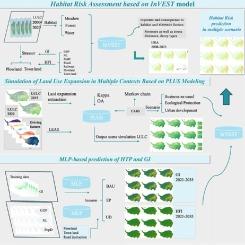多种情况下青藏高原生境风险的评估与预测
IF 7
2区 环境科学与生态学
Q1 ENVIRONMENTAL SCIENCES
引用次数: 0
摘要
青藏高原(QXP)是世界上海拔最高的高原,在极端的气候条件下形成了多种多样的生态景观;然而,该地区目前正面临着巨大的生态挑战。近年来,人类活动的增加,特别是人类足迹和放牧强度的扩大,大大加剧了该地区的生境风险压力。在这种情况下,需要进一步研究 QXP 不同情景下的未来生境风险趋势。针对这一空白,研究人员开发了一种综合的多情景栖息地风险预测方法,通过整合 InVEST 模型、斑块生成土地利用模拟模型和多层感知器模型,将土地利用和土地覆被数据与人类足迹指数和放牧强度数据相结合,对栖息地风险进行全面评估和预测。具体而言,分析了 2000 年至 2020 年 QXP 栖息地风险的时空变化,预测了未来指标,并评估了多种情景下栖息地风险的时空变化。研究结果表明,高风险区域在 2005 年大幅增加了 39%,但随后通过保护措施得到了缓解。在生态保护方案中,高生境风险降低了 74% 以上,而在城市发展方案中,高生境风险增加了 81%。2005 年至 2010 年间观察到的栖息地风险变化表明,青藏高原的生态保护工作卓有成效。在各种发展路径中,生态保护方案似乎是青藏高原最可行的方案。不过,青藏高原中部和东部地区的生境风险可能会继续呈上升趋势。本文章由计算机程序翻译,如有差异,请以英文原文为准。

Assessment and prediction of habitat risk on the Qinghai-Xizang plateau under multiple scenarios
The Qinghai-Xizang Plateau (QXP), the highest plateau in the world, boasts a diverse array of ecological landscapes shaped by extreme climatic conditions; however, it is currently facing significant ecological challenges. In recent years, an increase in human activities, particularly the expansion of the human footprint and grazing intensity, has significantly exacerbated the pressures on habitat risk in the region. In this context, the future habitat risk trend under different scenarios on the QXP require further investigation. To address this gap, a comprehensive multi-scenario habitat risk prediction methodology was developed to fill this gap by integrating the InVEST model, the patch-generating land use simulation model, and the multilayer perceptron model, which combined land use and land cover data with human footprint index and grazing intensity data for a thorough assessment and prediction of habitat risk. Specifically, spatiotemporal changes in habitat risk on the QXP from 2000 to 2020 were analyzed, future indicators were projected, and spatiotemporal variations in habitat risk were evaluated under multiple scenarios. The findings indicate that high-risk areas experienced a significant increase of 39% in 2005; however, this was subsequently mitigated by protective measures. In the Ecological Protection scenario, high habitat risk was reduced by over 74%, while the Urban Development scenario saw an increase of 81% in high habitat risk. The alterations in habitat risks observed between 2005 and 2010 indicate that ecological conservation efforts on the Qinghai-Xizang Plateau have been effective. Among the various development pathways, the Ecological Protection scenario appears to be the most viable for the QXP. Nonetheless, the central and eastern regions of the QXP may continue to face an upward trend in habitat risk.
求助全文
通过发布文献求助,成功后即可免费获取论文全文。
去求助
来源期刊

Ecological Indicators
环境科学-环境科学
CiteScore
11.80
自引率
8.70%
发文量
1163
审稿时长
78 days
期刊介绍:
The ultimate aim of Ecological Indicators is to integrate the monitoring and assessment of ecological and environmental indicators with management practices. The journal provides a forum for the discussion of the applied scientific development and review of traditional indicator approaches as well as for theoretical, modelling and quantitative applications such as index development. Research into the following areas will be published.
• All aspects of ecological and environmental indicators and indices.
• New indicators, and new approaches and methods for indicator development, testing and use.
• Development and modelling of indices, e.g. application of indicator suites across multiple scales and resources.
• Analysis and research of resource, system- and scale-specific indicators.
• Methods for integration of social and other valuation metrics for the production of scientifically rigorous and politically-relevant assessments using indicator-based monitoring and assessment programs.
• How research indicators can be transformed into direct application for management purposes.
• Broader assessment objectives and methods, e.g. biodiversity, biological integrity, and sustainability, through the use of indicators.
• Resource-specific indicators such as landscape, agroecosystems, forests, wetlands, etc.
 求助内容:
求助内容: 应助结果提醒方式:
应助结果提醒方式:


